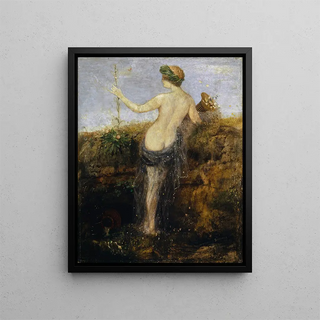Art print | Nymph with the Cornucopia - Arnold Böcklin


View from behind

Frame (optional)
Nymphe at the Cornucopia - Arnold Böcklin – Captivating Introduction
The artwork "Nymphe at the Cornucopia" by Arnold Böcklin is a piece that transports viewers into a universe that is both mythological and poetic. Painted at the end of the 19th century, it evokes themes of fertility, abundance, and beauty, embodied by the central figure of the nymph. This depiction of a delicate woman, surrounded by fruits and flowers, invites us to contemplate nature in all its splendor. The cornucopia, a symbol of prosperity, suggests a deep connection between man and the earth—a timeless message that still resonates today. Through this work, Böcklin offers us a glimpse of ideal beauty and the richness of life, while immersing us in a waking dream.
Style and uniqueness of the work
Böcklin's style is characterized by a skillful blend of realism and symbolism, creating an atmosphere that is both tangible and ethereal. In "Nymphe at the Cornucopia," vivid colors and meticulous details contribute to a lively and almost palpable representation of nature. Shadows and lights are expertly balanced, adding depth to the scene and emphasizing the beauty of the nymph. The composition is carefully orchestrated, with each element seeming to play a role in the overall harmony of the piece. The sensuality of the female figure, combined with the abundance of natural elements, creates a captivating tension between desire and serenity. This painting is a true ode to feminine beauty, while also celebrating the richness that nature has to offer.
The artist and his influence
Arnold Böcklin, a Swiss artist of the 19th century, is often regarded as one of the pioneers of symbolism. His artistic vision, marked by a fascination with mystery and the fantastical, influenced many artists of his time and subsequent generations. Böcklin drew inspiration from myths and legends, incorporating elements of classical mythology into his works. His unique approach to light and color not only redefined the landscape of painting but also left a lasting legacy in the art world.

Matte finish

View from behind

Frame (optional)
Nymphe at the Cornucopia - Arnold Böcklin – Captivating Introduction
The artwork "Nymphe at the Cornucopia" by Arnold Böcklin is a piece that transports viewers into a universe that is both mythological and poetic. Painted at the end of the 19th century, it evokes themes of fertility, abundance, and beauty, embodied by the central figure of the nymph. This depiction of a delicate woman, surrounded by fruits and flowers, invites us to contemplate nature in all its splendor. The cornucopia, a symbol of prosperity, suggests a deep connection between man and the earth—a timeless message that still resonates today. Through this work, Böcklin offers us a glimpse of ideal beauty and the richness of life, while immersing us in a waking dream.
Style and uniqueness of the work
Böcklin's style is characterized by a skillful blend of realism and symbolism, creating an atmosphere that is both tangible and ethereal. In "Nymphe at the Cornucopia," vivid colors and meticulous details contribute to a lively and almost palpable representation of nature. Shadows and lights are expertly balanced, adding depth to the scene and emphasizing the beauty of the nymph. The composition is carefully orchestrated, with each element seeming to play a role in the overall harmony of the piece. The sensuality of the female figure, combined with the abundance of natural elements, creates a captivating tension between desire and serenity. This painting is a true ode to feminine beauty, while also celebrating the richness that nature has to offer.
The artist and his influence
Arnold Böcklin, a Swiss artist of the 19th century, is often regarded as one of the pioneers of symbolism. His artistic vision, marked by a fascination with mystery and the fantastical, influenced many artists of his time and subsequent generations. Böcklin drew inspiration from myths and legends, incorporating elements of classical mythology into his works. His unique approach to light and color not only redefined the landscape of painting but also left a lasting legacy in the art world.






